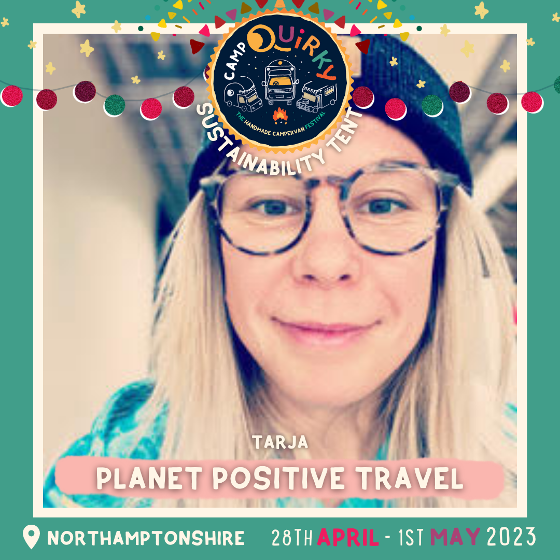Vanlife Landscapes goes (Camp) Quirky: greetings from a Traveling Post-Corona postdoc project
by Tarja Salmela

Greetings from the Vanlife Landscapes project - a postdoc project of mine under our larger project of Traveling Post-Corona! For the past year, the project has been running its own website and more recently an Instagram account (@vanlife_landscapes) where you can learn much, much more of the work I’ve been doing together with the vanlife community, tourism actors and destination management stakeholders in the Scottish Highlands and Northern Norway. Vanlife, what some would call a minimalist life on wheels and a growingly popular, to a degree nomadic lifestyle and community whose practitioners choose to live in a home-like converted vehicle either full- or part-time has begun to open up to me as a lifestyle mobility. As a lifestyle mobility, vanlife challenges any bounded and restrictive conceptualizations of living a life in a van – which makes it also hard to show statistical evidence of the vanlife community. We can read about statistics of new registrations of motor caravans or the trends in the rental market of campervans, as well as the increasing demand for professional conversions of vans, but many things slip away from our urge to grasp the phenomenon. Vanlifers come in different forms, motivations, histories, stories, and worldviews, and their floating presence in the midst of a growingly digitalized world is hard, even impossible, to grasp.
In the project, I’m interested in the ways the vanlife movement is developing and changing our conventional notions of travel, work, leisure, home and destination. I’ve been following the phenomenon especially in British and Norwegian contexts, but social media brings the stories from across the seas to my laptop, supplying endless amounts of vlogs, campervan DIY videos, and stories from the road to my head to get around. I have been utterly curious about the wider trends in buying and renting motorized caravans during the COVID-19 pandemic and how this is connected to local affordances and receptiveness of vanlife. I’m (painfully) aware of the problematics of campervan tourism in honey trap regions such as the Lofoten in Norway, and the Northern Highlands in Scotland, during the peak seasons. I’m aware of the problematics that arise from the collision of interest of travelers and locals which fueled my project in the first place. Thus the choices made about my fieldwork are in line with this problem setting. My project has taken me to the Scottish Highlands and the infamous NC500 route (read more about my journey here) as well as to a scenic coastal region in Northern Norway, Helgelandskysten, with its national tourist route Kystriksveien (see this post).
This year I will be traveling this national tourist route with a campervan, learning how campervan mobilities become possible together with the landscape, local communities, road network, and infrastructure - including campsites and waste stations. I will also be able to form understanding of how the islands of Helgeland, being tourism destinations themselves, connect with the tourist route and what stories do these connections enable the traveler to become part of. In addition to this I will be visiting Lofoten during the popular Trevarefest to witness (in addition to the festival atmosphere!) the realities of tourism flows and camping practices in the utterly popular destination in Northern Norway which has also known for its challenges regarding overtourism (for challenges regarding Lofoten, see e.g. this article).
Having learned a lot from the vanlife community during the past three years by following people’s stories on the road, I wanted to design a project that would build from the inspiration and knowledge of the worldwide vanlife community that would help to form bridges between campervan travelers and destination management especially in rural regions struggling from seasonal overtourism. These are regions where the needs and desires of the highly spontaneous and independent travelers with vans and motorhomes, and the needs and desires of the local communities, do not necessarily meet. This work is then supporting the work already rising from the vanlife community. We are seeing a wonderful bunch of initiatives and projects that include, for example, Motorhomes and Campervans Against Litter (MACAL) movement, and The Leave it Better Community. In more wider terms, the movement and growing community of Diversify Vanlife is doing a tremendous job in advocating the necessity of thinking and acting sustainably and responsibly when practicing a lifestyle on wheels fueled by a sense of freedom.
.png)
In a week's time I will be attending Camp Quirky vanlife festival, an authentic, sustainability-focused vanlife festival full of workshops, performances, inspiration, music and space to meet people who share a passion for campervans and the nomadic lifestyle. I will be one of the speakers in the Sustainability Tent at the festival with a theme ”Planet positive travel”, aiming to envision ways together with the festival folk how the vanlife community could be in the forefront of sustainable campervan travel. I hope that we will come up with a constructive response to the criticism many campervan and motorhome travelers face from both the tourism industry relying on conventional understandings of how ”tourism” works, and from communities suffering from overtourism and unsocial behavior by some campers. The outcomes of the project are to be communicated to destination management stakeholders in the Scottish Highlands, Helgelandskysten, Lofoten as well as the North Cape where we have negotiated potential collaboration in the future.
Keep yourself tuned to what’s going on in Vanlife Landscapes by following and sharing my blog
http://www.vanlifelandscapes.weebly.com/
and Instagram: @vanlife_landscapes.
See you on the road! Tarja